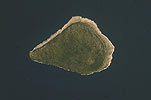Navassa

- ISS014-E-8889
- 01 December 2006
- 14:11 UTC
The small island of Navassa lies in the northeastern Caribbean Sea, located within the Jamaica Channel 54 km west from Cap des Irois (the westernmost point of Haiti's Tiburon Peninsula) and 135 km northeast from the island of Jamaica. The US claims the island as an unorganized unincorporated territory, managing it through the US Fish & Wildlife Service as the Navassa Island National Wildlife Refuge as part of the larger Caribbean Islands National Wildlife complex.
Teardrop-shaped in outline, the island of Navassa covers an area of 5.2 km² with a maximum length of 3.5 km (from northwest to southwest) and with a maximum width of 2.1 km from Northeast Point to Lulu Bay (top to bottom in the above image).
Arid in nature, the island consists of a flat to gently sloping plateau-like interior with average elevations of between 30 m above sea level (in the northwest) and 70 m (in the south). A maximum elevation of 77 m is reached in the southwest (100 m south of the island's lighthouse). The interior plateau drops abruptly via low cliffs and their associated scree slopes to a low terrace formation that surrounds the entire island. The sparsely vegetated terrace (cream-coloured in the above image) contains a karst-like terrain and is broadest on the eastern and northern side of the island and narrowest on the west coast north of Lulu Bay. Like the plateau of the interior the terrace itself drops via low cliffs of between 10 and 15 m in height directly to the sea — the only low-lying coastal area is a steep rocky beach found on the north coast. Coastal cliffs are often undercut and eroded to form caves.
Much of the main terrain features of Navassa (coastal cliffs, coastal terrace, scree slopes, terrace cliffs and interior plateau) can be seen in the accompanying aerial image that looks southwards along the east coast of the island.
The interior plateau contains a flora of low woodlands dominated by four main species: Short-leaf Fig (Ficus populnea var brevifolia), Mastic (Sideroxylon foetidissimum), Pigeon Plum (Coccoloba diversifolia), and Black Poison Wood (Metopium brownei). Vegetation cover is normally quite dense, although more open area occur particularly where phosphate mining (1865-1901) took place. The forests provide habitat for a variety of tropical bird species including over 5,000 nesting Red-footed Booby (Sula sula). In all there are some 120 terrestrial plant species, 650 species of invertebrate, and several endemic reptiles.
image: earth sciences and image analysis laboratory, nasa johnson space center






